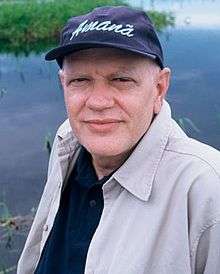José Márcio Ayres
| José Márcio Ayres | |
|---|---|
 José Márcio Ayres in 2002 | |
| Born |
José Márcio Corrêa Ayres February 21, 1954 Belém, Brazil |
| Died |
March 7, 2003 (aged 49) New York City, United States |
| Fields |
Conservation biology Primatology |
| Institutions |
Mamirauá Institute Museu Paraense Emílio Goeldi Wildlife Conservation Society |
| Alma mater |
University of São Paulo National Institute of Amazonian Research University of Cambridge |
| Academic advisors |
Paulo Vanzolini David J. Chivers |
| Notable students | Hélder Queiroz |
| Known for | Amazon conservation |
| Notable awards |
The Duke of Edinburgh Conservation Medal[1] Ordem Nacional do Mérito Científico[2] Rolex Awards for Enterprise[3] |
José Márcio Corrêa Ayres (February 21, 1954 – March 7, 2003) was a Brazilian primatologist and conservationist who founded the Mamirauá Sustainable Development Reserve in 1996, followed by the Amanã Sustainable Development Reserve in 1998.[4] The two reserves are located in the central region of the Brazilian state of Amazonas, and are joined to adjacent Jaú National Park to form a corridor spanning over 20,000 square miles (52,000 km2) of protected rainforest.[5]
Ayres devoted his life to the preservation of the unique biota and ecosystems of the Amazon, as well as to developing a method by which rural dwellers would benefit from the conservation of natural resources.[6] He realized that the uakari monkeys he had been studying for his doctoral thesis would stand no chance of survival unless new community-based models of natural resource management were applied to the much exploited Amazon River flood basin.[7]
Ayres' doctorate in primatology at Cambridge, in 1986, was for his thesis Uakaris and Amazonian flooded forest, the field work for which was undertaken on the upper Amazon River floodplain, near Tefé.[8][9]
Publications
- Ayres, José Márcio (1993). As Matas de Várzea do Mamirauá (in Portuguese). CNPq: Sociedade Civil Mamirauá.
- Ayres, J.M. (1985). "On a new species of squirrel monkey, genus Saimiri, from Brazilian Amazonia (Primates, Cebidae)". Papéis Avulsos de Zoologia.
- Ayres, J.M. (1989). "Comparative feeding ecology of the Uakari and Bearded Saki, Cacajao and Chiropotes". Journal of Human Evolution. 18: 697–716. doi:10.1016/0047-2484(89)90101-2.
- Ayres, J.M.; Clutton-Brock, T.H. (1992). "River Boundaries and Species Range Size in Amazonian Primates". The American Naturalist. 140: 531. doi:10.1086/285427.
- Mittermeier, R.A.; Schwarz, M.; Ayres, J.M. (1992). "A new species of marmoset, genus Callithrix Erxleben, 1777 (Callitrichidae, Primates) from the Rio Maués region, state of Amazonas, central Brazilian Amazonia" (PDF). Goeldiana Zoologia.
- Pimm, Stuart L.; Ayres, Márcio; Balmford, Andrew; et al. (2001). "Can We Defy Nature's End?" (PDF). Science. 293: 2207–8. doi:10.1126/science.1061626. PMID 11567124.
References
- ↑ "The Duke of Edinburgh Conservation Medal". WWF.
- ↑ "Membros da Ordem Falecidos". Ministério da Ciência, Tecnologia e Inovação.
- ↑ "José Márcio Ayres: Overview". Rolex Awards for Enterprise.
- ↑ Saxon, Wolfgang (March 11, 2003). "José Márcio Ayres Dies at 49; Saved Heart of the Amazon". The New York Times.
- ↑ "Central Amazon Conservation Complex". UNESCO World Heritage Centre.
- ↑ Lima, Deborah (2011). "The Contribution of Márcio Ayres to a Transdisciplinary Approach to Conservation". In Pinedo-Vasquez, Miguel; Ruffino, Mauro L.; Padoch, Christine; Brondízio, Eduardo S. The Amazon Várzea. Springer. ISBN 978-94-007-0145-8.
- ↑ Ayres, J.M. (1986). "The conservation status of the white uakari" (PDF). Primate Conservation.
- ↑ "University of Cambridge - Library Search".
- ↑ Ayres, J.M. (1986). Uakaris and Amazonian flooded forest (Ph.D.). University of Cambridge.